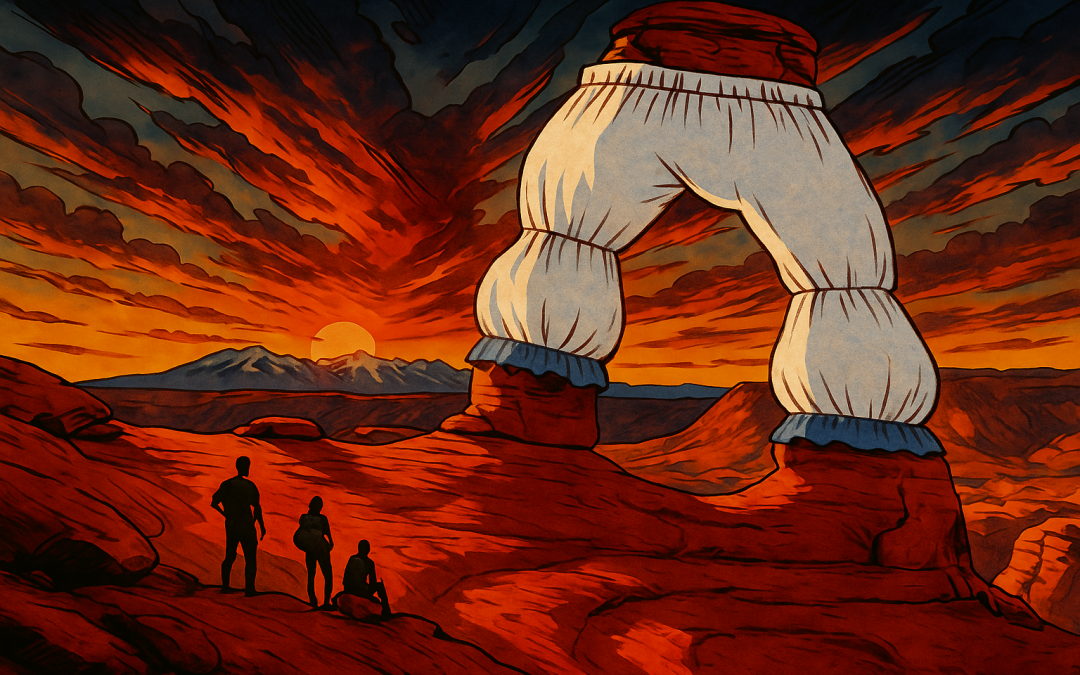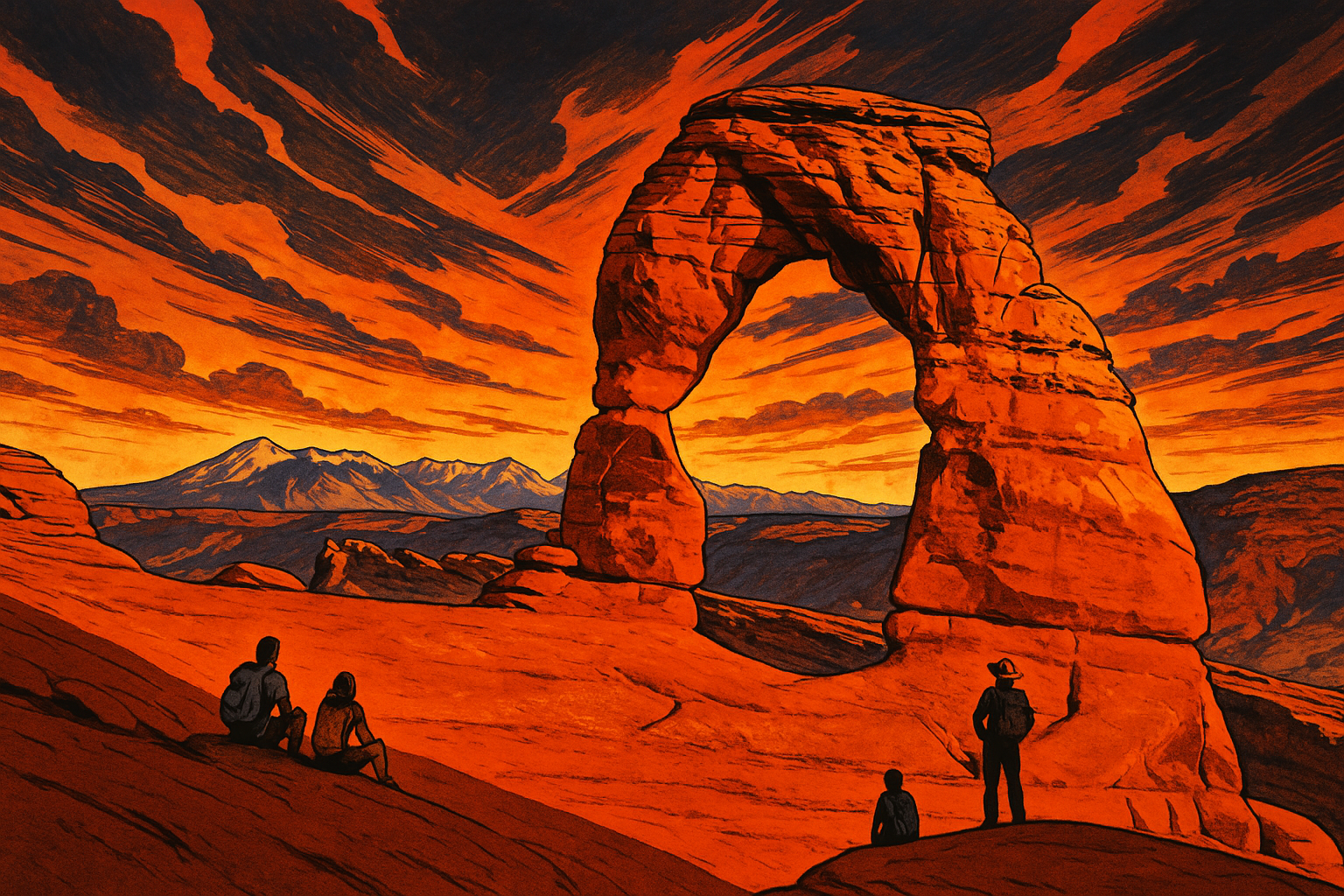If you’ve ever seen Utah’s license plate, a tourism brochure, or even a photo collection of the American Southwest, you’ve probably seen Delicate Arch. It rises out of the sandstone like something impossibly sculpted, a perfect window into desert skies and snowy mountain peaks. Standing beneath it for the first time, most people are struck by its size, its power, and its improbable balance. “Delicate” doesn’t always feel like the right word. But the story of how Delicate Arch got its name is as fascinating as the hike to reach it.
This is a tale of cowboys and scientists, early tourism and modern marketing, and how a single word transformed a rock formation into one of the most famous icons in the world.
Before It Was Called Delicate Arch
Indigenous Presence in the Landscape
Long before it was called anything in English, this arch was part of a living landscape for Indigenous peoples. The Ute petroglyphs carved near the Wolfe Ranch trailhead date back hundreds of years, depicting horseback riders and bighorn sheep. These carvings are reminders that this landscape was never empty—it was (and remains) part of a cultural heritage.
Unfortunately, no recorded Indigenous name for Delicate Arch survives in written history. But to imagine that it was unnamed would be wrong; the absence of record is not the absence of story.
Ranchers and Cowboys Encounter the Arch
By the mid-1800s, ranchers were grazing cattle in the Moab area. They came across the arch, but it wasn’t seen as a wonder to be promoted—it was simply another formation among many. Locals gave it informal nicknames based on what they saw.
Some called it “The Schoolmarm’s Bloomers,” saying it resembled the draped fabric of old-fashioned undergarments. Others referred to it as “The Cowboy’s Chaps” or “Pants Crotch Arch.” These names may sound odd (or crude) today, but they reflect how early settlers saw the formation through the lens of everyday life.
None of these names stuck, and none had the sense of timelessness that the arch seemed to deserve.
The Naming of Delicate Arch
A Chance Description in the 1930s
The shift came in 1934, when Laurence J. Morehouse, a geography professor from the University of Utah, and his wife Charmaine, a botanist, visited the formation. In their field notes, they described it as “the most delicate arch in the area.”
That phrase—casual, observational, almost offhand—was the spark. Where earlier nicknames had been playful or irreverent, “delicate” captured both the appearance and the feeling the arch inspired. It suggested fragility and grace, something improbably balanced against time.
Adoption by the National Park Service
The name “Delicate Arch” began appearing in guidebooks and park literature soon after. The National Park Service, which was still working to promote Arches (then a national monument), adopted the name. By the 1940s, it was the official label used in maps and promotional material.
It’s worth noting that many of the formations in Arches National Park got their names this way—casual observations that stuck, often by visiting geologists or park staff. Names like Landscape Arch, Double Arch, and Balanced Rock were not ancient titles, but descriptive tags given in an era of growing tourism.
Utah’s Iconic Symbol
Gaining Popularity
Through the 20th century, as roads improved and Moab opened up to tourism, Delicate Arch began to attract attention. Photographers sought it out for its symmetry. Hikers made the climb for the thrill of standing beneath its span. Guidebooks declared it the “must-see” of the monument.
By the time Arches was upgraded from national monument to national park in 1971, Delicate Arch was firmly established as its crown jewel.
A Statewide Icon
In 1992, Utah redesigned its license plate to feature Delicate Arch in bold red against a desert background. This was a turning point. Suddenly, the arch wasn’t just a feature of a park near Moab. It had become a symbol of Utah itself.
When the Olympic Games came to Salt Lake City in 2002, the Olympic torch was carried beneath the arch. That moment broadcast Delicate Arch around the world, cementing its place as one of the most recognizable natural landmarks in America.
Why the Name Delicate is Still Relevant
A Word that Fits
Hike the 1.5-mile trail today and you’ll see why the name works. The arch is tall (52 feet) and wide (32 feet), but compared to other formations in Arches, it feels exposed and fragile. It stands alone, unsupported by canyon walls. From certain angles, it looks like a giant stone teacup balanced on spindly legs.
It’s not the world’s longest sandstone arch like Landscape Arch. It’s not a unique double arch like the Double O. It’s not precariously balanced like Balanced Rock. It is just simply delicate.
A Reminder of Time’s Power
Geologists remind us that arches are temporary. Wind, water, and gravity are constantly working to weaken and eventually destroy them. The word “delicate” reminds us of the fleeting nature of these formations. Just as Wall Arch collapsed in 2008, Delicate Arch will one day fall. Its name feels almost prophetic.
Fun Facts About Delicate Arch’s Name
First written use of “Delicate Arch”: 1934, in notes by Laurence and Charmaine Morehouse.
Other names it went by: Schoolmarm’s Bloomers, Cowboy’s Chaps, Pants Crotch Arch.
Official adoption: By the National Park Service in the mid-20th century.
Cultural appearances: Utah’s license plate (since 1992), Olympic torch relay (2002).
Insider Tips for Visiting Delicate Arch
Trailhead: Wolfe Ranch, inside Arches National Park.
Distance: 3 miles round trip.
Elevation Gain: About 480 feet.
Average Time: 2–3 hours, depending on pace.
Best Time to Hike: Sunrise and late afternoon for soft light and fewer crowds.
Pro Tip: Bring water—even in cooler months. The final stretch has no shade.
Final Thoughts: A Name That Became a Legacy
Delicate Arch could have been “Cowboy’s Chaps Arch.” It could have remained an unnamed feature, one of thousands in the Utah desert. Instead, a single descriptive word, a somewhat off-hand remark, reshaped its destiny.
Today, “Delicate” doesn’t just describe the arch. It defines it. It has turned sandstone into symbol, geology into identity, and Moab into a place the world knows by a single image.
The next time you hike up to Delicate Arch, stand beneath its span and look up. Think about the power of names. Think about how a word can change the way we see the world. And think about how this arch, delicate yet enduring, continues to inspire millions every year.
Frequently Asked Questions: Delicate Arch
When was Delicate Arch named?
The name “Delicate Arch” first appeared in 1934, when University of Utah professors Laurence and Charmaine Morehouse described it as “the most delicate arch in the area.” The National Park Service adopted the name soon after, and it became official in park literature by the mid-20th century.
What was Delicate Arch called before?
Before the 1930s, locals gave Delicate Arch playful nicknames like “The Schoolmarm’s Bloomers,” “The Cowboy’s Chaps,” and “Pants Crotch Arch.” None of these names stuck, and eventually the descriptive term “delicate” replaced them.
Why is it called Delicate Arch?
The name reflects the arch’s slender, freestanding form. Unlike other arches in the park, which are connected to canyon walls or buttressed by rock fins, Delicate Arch stands alone. Its thin legs and balanced shape make it look fragile, even though it is more than 50 feet tall.
Why is Delicate Arch famous?
Delicate Arch is Utah’s most iconic landmark. It appears on the state license plate, was featured during the 2002 Winter Olympics torch relay, and has become one of the most photographed natural arches in the world. Its dramatic setting against the La Sal Mountains makes it a must-see for visitors to Arches National Park.
Will Delicate Arch collapse?
Yes, eventually. Like all natural arches, Delicate Arch will one day fall due to erosion. Geologists can’t predict exactly when, but examples like the collapse of Wall Arch in 2008 remind us that these formations are temporary. For now, Delicate Arch continues to stand strong and attract millions of visitors every year.


